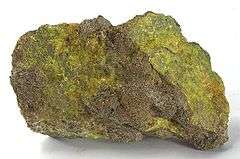Idrialite
| Idrialite | |
|---|---|
|
Idrialite, Skaggs Springs Mine, Sonoma County, California (size: 6.3 x 4.1 x 1.8 cm | |
| General | |
| Category | Organic mineral |
| Formula (repeating unit) | C22H14 |
| Strunz classification | 10.BA.20 |
| Dana classification | 50.03.08.01 |
| Crystal system |
Orthorhombic Unknown space group |
| Unit cell |
a = 8.07, b = 6.42 c = 27.75 [Å]; Z = 4 |
| Identification | |
| Color | Greenish yellow, light brown, colorless |
| Cleavage | {001}, perfect; {100}, poor |
| Fracture | Conchoidal |
| Mohs scale hardness | 1.5 |
| Luster | Vitreous to adamantine |
| Specific gravity | 1.236 |
| Optical properties | Biaxial (+) |
| Refractive index | nα= 1.557 nβ = 1.734 nγ = 2.07 |
| Pleochroism | X = pale yellow; Y = Z = yellow |
| 2V angle | 84° |
| Ultraviolet fluorescence | Short UV=blue, orange, yellow, green white |
| References | [1][2][3] |
Idrialite, or idrialine, is a soft, orthorhombic hydrocarbon mineral with chemical formula: C22H14.[1][2][3] It is usually greenish yellow to light brown in color with bluish fluorescence.
Raman spectroscopy studies indicate that it may be a mixture of complex hydrocarbons including benzonaphthothiophenes (chemical formula: C16H10S) and dinaphthothiophenes (chemical formula: C20H12S).[4]
Discovery and occurrence
It was first described in 1832 for an occurrence in the Idrija region west of Ljubljana, northwestern Slovenia.[2] It also occurs at Skaggs Springs, Sonoma County, western Lake County and the Knoxville Mine in Napa County, California.[1] It has also been reported from localities in France, Slovakia and Ukraine.[2]
It can be found mixed with clay, pyrite, quartz and gypsum associated with cinnabar in the Idrija occurrence and with metacinnabar, realgar and opal in the Skaggs Spring location.[1]
Its combustibility gave rise to the term "inflammable cinnabar", which is one of its synonyms.
References
| Wikimedia Commons has media related to Idrialite. |
